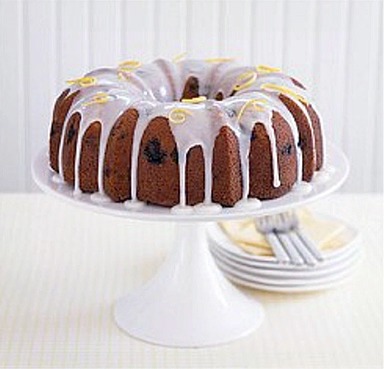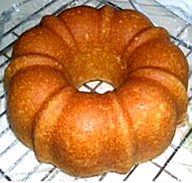Variation: Buttermilk Blueberry Bundt Cake

stock photo

Buttermilk in the recipe makes for a tender and moist cake.
CAKE RECIPE HELP
Meg, Premium Member, Says: “That buttermilk bundt cake is great! I make that all the time….and it takes well to all kinds of variations (mix-ins, flavorings, etc.). I've made a lemon buttermilk quickbread – the recipe was in an old issue of Food & Wine, I believe. But the texture was a little funky…..I much prefer the BBC recipe that's on this site.”
INGREDIENTS
Cake
3 cups unbleached all-purpose flour; spoon into dry measuring cup and level to rim
1 1/2 teaspoons baking powder
1/2 teaspoon baking soda
1/2 teaspoon salt
1 1/2 sticks unsalted butter, cold
2 cups sugar or superfine sugar
3 large eggs, cold
1 1/2 cups buttermilk, well shaken
2 teaspoons pure vanilla extract
Pourable Icing
1 cup powdered sugar, sifted; sift after measuring
1/8 cup unsalted butter, softened
2 – 3 teaspoons whole or 2% milk
1/8 teaspoon vanilla extract
1/4 cup almond slices
INSTRUCTIONS
1. Position the oven rack in the center of the oven and preheat to 350 degrees F.
Spread almond slices on a piece of foil and place in preheating oven to toast for 5 to– 7 minutes. Toss half way thorough and DO NOT leave unchecked. Set aside and let cool.
2. Generously grease an a 12-cup bundt or 10-inch tube pan (1 piece) with a pastry brush with shortening or spray with Baker’s Joy or vegetable oil spray. Cakes notoriously stick to bundt pans, so get every nook and cranny with a pastry brush and make sure every area is evenly covered. With a paper towel, lightly smooth any pockets of shortening. Use a fluted bundt pan, not an intricate one because cake is a little soft and small patterns won’t show.
3. In a medium size bowl, combine flour, baking powder, baking soda and salt with a spoon. Set aside.
4. Cream butter with sugar: Cut butter into large chunks. Begin at low speed to first soften the butter. Then increase the mixer to medium, for approximately 45 to 60 seconds, until it is smooth. Beat fat into a plastic-like consistency. DO NOT OVERBEAT. If the butter is cold, the process takes a bit longer.
With the mixer still set on medium, slowly add in the sugar at the side of the bowl. The best way is to add it 1 tablespoon at a time, taking 8 to 10 minutes to complete. But, if you don't have the time, which I never do, you can slowly add the sugar in a steady stream at the side of the bowl while mixing, taking half the time suggested.
Scrape the sides and the bottom of the bowl often with a rubber spatula. The beaters will begin to form ridges in the butter from mixing. Stop creaming when the mixture becomes light in color and fluffy in texture from the millions of puffy air cells.
5. With the mixer on low, add eggs, one at a time and beat 20 seconds after each addition. Mix the buttermilk with the vanilla extract. With the mixer still on low speed, add flour mixture in 3 portions, alternating with the buttermilk mixture, starting and stopping with the flour mixture. Scrape the bowl and increase speed to medium and beat 1 to 1-1/2 minutes. Scrape into the prepared pan and lightly smooth the top. Remember to get every last bit from the bowl with a rubber spatula. The pan should be about ½-full.
6. Bake the cake for 60 minutes or until the cake springs back when lightly touched in the center. If using a tube pan, press the cake in between the walls of the pan and the central tube. Take from the oven to a wire cake rack and let sit for 10 minutes. Loosen the sides with a small metal spatula or sharp knife. Invert onto greased rack and place upright to cool completely.
7. Meanwhile, prepare icing: with a mixer on low, beat together butter. Add vanilla, sugar and then enough milk to make a slow, pourable icing. Cover.
Assembly: When cake has cooled, put on a wire cake rack set over a piece of waxed or parchment paper. Pour icing over top. Sprinkle on top with toasted almond slices. Let icing set, about 10 – 15 minutes and serve.
STORAGE
Store frosted cake at room temperature under an inverted glass bowl or cake keeper for about 5 days. If you want to keep your unfrosted cake layer longer, freeze it. If frosted, place cake in the freezer to harden the frosting before covering. Wrap the cake in plastic wrap and then in foil. Place inside of a resealable plastic bag. Keeps for 2 – 3 months. Icing keeps for two weeks at room temperature, but best used when just made. Whip before using.
QUESTION: The frosting has milk in it, so is it safe to store at room temperature rather than refrigerating?
SARAH SAYS: The sugar in the recipe acts as a preservative for the milk. It only works in most high sugar frostings.
ICING VARIATION
Instead of a pourable icing a Confectioner’s Sugar Glaze works just as well. Combine: 1-1/4 cups confectioner’s sugar and 3 tablespoons milk.
ADD FRUIT
Fold in 1/2 cup blueberries after mixing.


